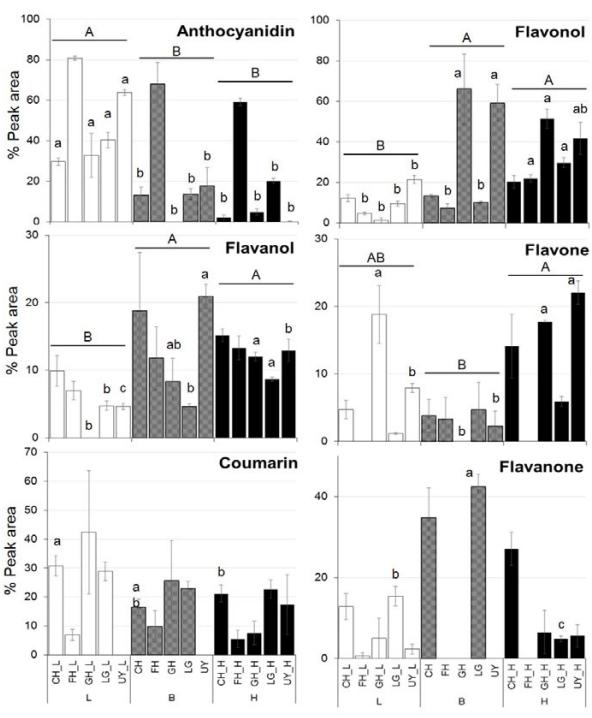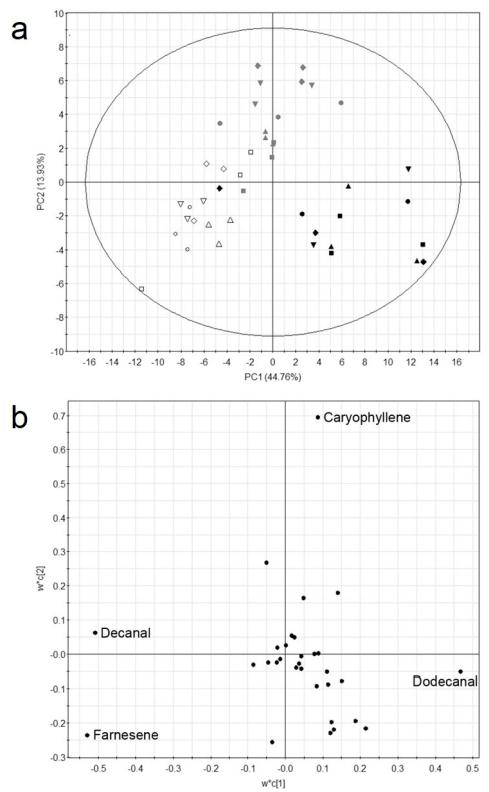What are Aldehyde Metabolites?
Aldehyde metabolites are organic compounds that act as intermediates in various metabolic processes within living organisms. Derived from aldehydes, these compounds contain a carbonyl group (C=O) at the end of their carbon chain. Aldehyde metabolites play crucial roles in the metabolism of carbohydrates, lipids, and amino acids.
These metabolites serve as biomarkers, offering valuable insights into cellular health and functioning, making them essential for scientific investigations and research. Creative Proteomics provides comprehensive aldehyde metabolite analysis services, including profiling, targeted analysis, identification of unknown metabolites, and derivatization analysis.
Our state-of-the-art techniques, such as LC-MS, GC-MS, and HRMS, allow for accurate quantification and structural elucidation of aldehyde compounds. Researchers can gain a deeper understanding of aldehyde metabolism, stress responses, plant-environment interactions, and applications in crop improvement and natural product evaluation through our specialized services.
Aldehyde Metabolite Analysis Service Provided by Creative Proteomics
1. Aldehyde Metabolite Profiling
This service involves the comprehensive profiling of aldehyde metabolites present in biological samples. Using state-of-the-art mass spectrometry-based techniques, Creative Proteomics identifies and quantifies a wide range of aldehyde metabolites, enabling researchers to obtain a detailed overview of metabolic pathways and disease-related alterations.
2. Targeted Aldehyde Metabolite Analysis
For researchers interested in specific aldehyde metabolites, Creative Proteomics offers targeted analysis services. By customizing analytical methods, the company can focus on the detection and quantification of particular aldehyde species, enhancing the sensitivity and specificity of the analysis.
3. Aldehyde Metabolite Identification
Creative Proteomics excels in the identification of unknown aldehyde metabolites. Through advanced mass spectrometry coupled with extensive databases and bioinformatics analysis, the company helps researchers elucidate the structures of novel aldehyde metabolites, paving the way for further investigations into their biological roles.
4. Aldehyde Derivatization Analysis
To improve the detection limits and stability of aldehyde metabolites, Creative Proteomics offers derivatization analysis services. By chemically modifying aldehyde groups, the sensitivity of mass spectrometry detection is enhanced, enabling the detection of trace amounts of metabolites that would otherwise be challenging to quantify.
Aldehyde Metabolite Analysis Techniques and Instrument
Liquid Chromatography-Mass Spectrometry (LC-MS): The Agilent 6460 Triple Quadrupole LC-MS/MS System is a state-of-the-art instrument employed for LC-MS-based aldehyde metabolite analysis. With its high sensitivity and selectivity, this system allows for the precise quantification of aldehydes in various biological matrices. Its triple quadrupole configuration enables targeted analysis, making it particularly useful in investigating specific aldehyde species of interest.
Gas Chromatography-Mass Spectrometry (GC-MS): The Thermo Scientific TSQ 8000 Evo GC-MS/MS System is a powerful instrument used for GC-MS-based aldehyde metabolite analysis. Equipped with a high-performance mass selective detector, this system ensures accurate quantification and structural elucidation of volatile aldehydes.
High-Resolution Mass Spectrometry (HRMS): The Waters Xevo G2-XS QTof HRMS System is a top-tier instrument in HRMS-based aldehyde metabolite analysis. With its exceptional resolution and mass accuracy, this system enables confident identification and structural elucidation of aldehydes even in complex samples.
Tandem Mass Spectrometry (MS/MS): The SCIEX QTRAP 6500+ LC-MS/MS System is an exemplary instrument used in MS/MS-based aldehyde metabolite analysis. Combining triple quadrupole and linear ion trap technologies, this system enables targeted quantification, as well as enhanced structural elucidation through multiple reaction monitoring (MRM) and enhanced product ion (EPI) scans.
 Workflow for Plant Metabolomics Service
Workflow for Plant Metabolomics Service
List of Aldehyde Metabolite Analyzed (including but not limited to)
| Types |
Compounds |
| Carbohydrate Metabolism |
Glycolaldehyde, Glucose-6-phosphate, Sorbitol, Glyceraldehyde, Glucuronolactone, Xylulose, Xylose |
| Amino Acid Metabolism |
Gluteraldehyde, Methylglyoxal, Glyoxal, 3-Formylpyruvate, 4-Aminobutyraldehyde, Glutaric semialdehyde |
| Lipid Metabolism |
Malondialdehyde, Acrolein, 4-Hydroxynonenal, 4-Hydroxyhexenal, 4-Hydroxynon-2-enal, 4-Oxo-2-nonenal |
| Oxidative Stress |
4-Hydroxyhexenal, 4-Hydroxynonenal, Furfural, 2,4-Nonadienal, 4-Hydroxy-2-hexenal |
| Detoxification |
Acetaldehyde, Glutathione-S-aldehyde, Benzaldehyde, Nitrosobenzaldehyde, 2,4-Dinitrobenzaldehyde |
| Environmental Exposure |
Formaldehyde, Crotonaldehyde, Acrylaldehyde, Propionaldehyde, Benzaldehyde, Acrolein |
Sample Requirements for Aldehyde Metabolite Assay
| Sample Types |
Minimum Sample Size |
| Plant Samples |
Roots, stems and leaves, floral parts, fruits/seeds, rhizomes, buds/tender leaves, tissue sections, pollen, bark, trunk/wood, resin/gum, resin acids, seedlings/young plants, rhizosphere soil, root exudates. |
100 mg - 1 g |
| Animal Samples |
Tissues |
100 mg - 1 g |
| Cell Samples |
Cells and Culture |
106 - 108 cells |
Analyzing Aldehyde Metabolite Can Help:
Understanding Plant Metabolism:
Plant metabolomics is essential for understanding the complex biochemical processes within plants. Aldehyde metabolite analysis helps unravel the intricate metabolic pathways, enabling researchers to explore how plants synthesize and utilize aldehydes for growth, defense, and adaptation to various environmental challenges.
Studying Stress Responses:
Plants encounter various stressors, such as drought, salinity, pathogens, and pollutants. Aldehyde metabolite analysis aids in investigating stress responses, as aldehydes are involved in signal transduction and stress tolerance mechanisms. Our services contribute to a deeper understanding of how plants cope with adverse conditions and adapt to their surroundings.
Insights into Plant-Environment Interactions:
Environmental factors significantly impact plant growth and survival. Our analysis of aldehyde metabolites in plants helps assess the effects of environmental cues, providing valuable information on plant responses to temperature changes, light conditions, and exposure to pollutants.
Enhancing Crop Improvement:
In agriculture, optimizing crop productivity is paramount. Aldehyde metabolite analysis offers insights into plant secondary metabolism, which contributes to crop quality and defense against pests and diseases. Our services support crop breeding and biotechnological approaches for crop improvement.
Evaluating Plant Secondary Metabolites:
Secondary metabolites, including aldehydes, play diverse roles in plant defense, attraction of pollinators, and allelopathy. Our analysis assists in the evaluation of these compounds, aiding in the identification of potential natural products with medicinal or agricultural applications.
Case 1. Temperature-Induced Metabolic Changes in Polygonum minus: VOC and Flavonoid Analysis
Background:
Plant growth is influenced by temperature, and plants can adapt to environmental stress by regulating physiological processes. Temperature changes can induce alterations in plant metabolism and composition of plant metabolites to counteract oxidative stresses caused by reactive oxygen species (ROS). Secondary metabolites, such as phenolics, terpenes, and nitrogen and sulfur-containing compounds, play essential roles in plant protection against abiotic stresses.
Samples:
The study focused on Polygonum minus, a plant species from the Polygonaceae family. Stem cuttings were collected from three highland populations (Cameron Highland, Genting Highland, Fraser Hill) and two lowland populations (Ulu Yam, Lenggeng) and propagated in controlled environment chambers under different temperature regimes.
Methods:
1. Sample Collection and Preparation:
Stem cuttings of Polygonum minus were collected from three highland populations (Cameron Highland, Genting Highland, Fraser Hill) and two lowland populations (Ulu Yam, Lenggeng). Nine stem cuttings from each population were propagated in M3 compost and grown in controlled environment chambers. After six weeks of growth, new leaves from the third to sixth node of the stem were harvested, immediately immersed in liquid nitrogen, and stored at -80°C until analysis.
2. Solid Phase Microextraction (SPME) for VOC Analysis:
Volatile organic compounds (VOCs) were analyzed using SPME followed by GC-MS analysis. A polydimethylsiloxane (PDMS) fiber was conditioned at 250°C before each extraction. Approximately 300 mg of fresh leaves were ground with liquid nitrogen and placed in a vial. Distilled water was added, and the vial was sealed to prevent volatile escape. The PDMS fiber was exposed to the sample headspace for 20 minutes at 45°C, capturing the volatile compounds. The fiber was then thermally desorbed in the GC injector at 250°C for 10 minutes. Three biological and three technical replicates were used for each analysis.
3. GC-MS and GC-FID Analysis for VOC Identification and Quantification:
GC-MS analysis was conducted using a gas chromatograph Clarus 600 T series with a Clarus 600 mass spectrometric detector. A 30-m × 0.25-mm × 0.25-μm Elite-5MS column was used for separation. The column temperature was increased from 40°C to 220°C at a rate of 4°C/min. Ionization voltage of 70 eV and mass scan range of 50-600 Da were used for MS analysis. GC-FID analysis was performed using a Hewlett Packard 5890 system with a DB-5HT column. n-alkane standard solutions were used for retention index determination.
4. Flavonoid Extraction and LC-TOF-MS Analysis:
Flavonoids were extracted based on a modified method using methanol. Approximately 500 mg of freeze-dried samples were ground and extracted with methanol. The extracts were filtered and subjected to LC-TOF-MS analysis using a photodiode array detector. A reversed-phase C18 analytical column was used for separation with formic acid and acetonitrile as mobile phases. The TOF detector was operated in positive-ion mode with mass range 50-1000 m/z.
5. Statistical Analysis:
Statistical analysis was performed using ANOVA and Tukey's multiple comparison tests to determine significant differences in metabolite composition between temperature treatments and populations. Multivariate analysis including PCA and PLS-DA was used to explore sample clustering and the contribution of specific compounds to the separation. Heatmaps and hierarchical clustering were generated for data visualization. Venn diagrams were used to identify unique compounds in different populations.
Results
Temperature significantly influenced the composition of VOCs and flavonoids in different plant populations. Higher temperature treatment led to increased terpenes and decreased aldehydes in VOCs. Flavonols and flavanols content increased at higher temperature, while anthocyanidins were more abundant at lower temperature. Interpopulational variations in response to temperature were observed, with different populations showing distinct metabolite profiles. The effect of temperature on plant metabolism varied depending on the origin of the plant populations.
 Heatmap of relative abundance of different terpenes in P. minus grown under baseline, lower and higher temperature treatments.
Heatmap of relative abundance of different terpenes in P. minus grown under baseline, lower and higher temperature treatments.
 PLS-DA model obtained from the classification of P. minus samples based on volatile compounds according to the temperature treatments
PLS-DA model obtained from the classification of P. minus samples based on volatile compounds according to the temperature treatments
Reference
- Goh, H‐H., et al. "Metabolite profiling reveals temperature effects on the VOC s and flavonoids of different plant populations." Plant Biology 18 (2016): 130-139.


 Workflow for Plant Metabolomics Service
Workflow for Plant Metabolomics Service Heatmap of relative abundance of different terpenes in P. minus grown under baseline, lower and higher temperature treatments.
Heatmap of relative abundance of different terpenes in P. minus grown under baseline, lower and higher temperature treatments. PLS-DA model obtained from the classification of P. minus samples based on volatile compounds according to the temperature treatments
PLS-DA model obtained from the classification of P. minus samples based on volatile compounds according to the temperature treatments

